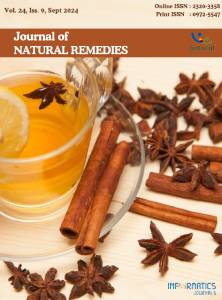Pharmaceutical Standardization and Comparative Study of Varunadi Kvatha Churna as Varunadi Ghana Vati/Tablet and Varunadi Pravahi Kvatha
DOI:
https://doi.org/10.18311/jnr/2024/36240Keywords:
Ayurvedic, Ayurveda, Decoction, Ghana, Kvatha, Pravahi KvathAbstract
Background: In Ayurveda, there are many types of potent dosage forms available with their different specifications, anupan, preparation procedure and shelf life. The preparation of medicines of herbal drug origin is generally included in the Bhaishajya Kalpana section. In Bhaishajya Kalpana there are five basic dosage forms necessary to prepare formulations from herbal origin drugs i.e. Swarasa, Kalka, Kvatha, Hima and Phanta. These five basic formulations are potent dosage forms which can moulded into different finished formulations. Aim: The objectives of this study were to prepare and standardise the Varunadi Kvatha Churna as Varunadi Ghana Vati/Tablet and Varunadi Pravahi Kvatha with a comparative study. Methods: Firstly, kvatha churna was prepared as per the master formula. The kvatha churna was then used in two different ways i.e. firstly it was used to prepare Varunadi Ghana Vati (Tablet) without using any additives as it acts as a self-binder. On the other hand, Pravahi kvatha was prepared which is a self-generated alcohol formulation, in which dhataki pushpa, gudda and babool are added as a fermentation initiator and additives. Results: Physicochemical parameters do not show significant variation. According to the TLC profile, the Ghana Vati has six spots i.e. having much more active constituents than the Pravahi kvatha having two spots. Therefore, according to the parameters, it might be stated that the Pravahi kvatha has much more stability than the Ghana Vati. But as far as palatability and activity are concerned Ghana Vati is comparatively better than Pravahi kvatha Conclusion: Converting Varunadi Kvatha Churna into Varunadi Ghana Vati, Varunadi Pravahi Kvatha provides several benefits related to ease of use, dosage precision, and patient preference. Hence based on observation we stated that the Varunadi Ghana Vati has a better choice of dosage form as compared to Varunadi Pravahi Kvatha, although it has better stability.
Downloads
Metrics
Downloads
Published
How to Cite
License
Copyright (c) 2024 Gurmeet Singh, Priyanka Chaudhary, Mohit Sharma, Vaishnavi, Ankit Kumar Yadav, Saurabh Singh, Bimlesh Kumar, Narendra Kumar Pandey, Sachin Kumar Singh, Anand Kumar Choudhary, Dileep Singh Baghel (Author)

This work is licensed under a Creative Commons Attribution 4.0 International License.
Accepted 2024-07-10
Published 2024-10-07
References
Chattopadhyay K. Globalisation of Ayurveda: the importance of scientific evidence base. Herbal Medicine in India: Indigenous Knowledge, Practice, Innovation and its Value. 2020. p. 3-7. https://doi.org/10.1007/978-981-13-7248-3_1
Sharma S, Baghel DS. Ayurceuticals: A progressive opportunity in wellness and medical tourism. Journal of Pharmacy Research. 2017; 11(7):903-11.
Jaiswal YS, Williams LL. A glimpse of Ayurveda-The forgotten history and principles of Indian traditional medicine. Journal of Traditional and Complementary Medicine. 2017; 7(1):50-3. https://doi.org/10.1016/j.jtcme.2016.02.002 PMid:28053888 PMCid: PMC5198827
Baghel DS. Impact of particle size of Kwathyadravya (Decoction powder) in the preparation of phaltrikadi kwath. Asian J Pharm Clin Res. 2018; 11(4):262-6. https://doi.org/10.22159/ajpcr.2018.v11i4.23977
Bhaskaran B. Rationality of pharmaceutical preparations in Ayurveda. J Ayurveda Integr Med. 2016; 1(3):124-7. https://doi.org/10.21760/jaims.v1i3.4428
Kumari A, Dwivedi A, Bilas RN. Churna Kalpana- A classical and contemporary review. World J Pharm Res. 2022; 11(6):298-303.
Martins N, Barros L, Santos-Buelga C, Silva S, Henriques M, Ferreira IC. Decoction, infusion and hydroalcoholic extract of cultivated thyme: Antioxidant and antibacterial activities, and phenolic characterisation. Food Chem. 2015; 167:131-7. https://doi.org/10.1016/j.foodchem.2014.06.094 PMid:25148969
Arote P, Chavan S. Review article on Kwatha Kalpana. J Ayurveda Integr Med. 2020; 5(06):220-3.
Meena VSB, Chaudhary AK. Kwatha Kalpana: It’s versatility with probable advancement. Asian J Pharm. 2017; 11(04): S678-S84.
Chanda S. Importance of pharmacognostic study of medicinal plants: An overview. J Pharmacogn Phytochem. 2014; 2(5):69-73.
Sarker SD. Pharmacognosy in modern pharmacy curricula. Pharmacogn Mag. 2012; 8(30):91-2. https://doi.org/10.4103/0973-1296.96545 PMid:22701278 PMCid: PMC3371443
De Pasquale A. Pharmacognosy: the oldest modern science. J Ethnopharmacol. 1984; 11(1):1-16. https://doi.org/10.1016/0378-8741(84)90092-8 PMid:6381886
Sharma A, Baghel DS, Mittal A, Singh S. Standardization and comparative study of Guduchi Churna, Guduchi Ghan Vati and Guduchi Satwa. Think India Journal. 2019; 22(17):509-19.
Sharma SDSB, Singh S, Singh SK. Dosage form development and preliminary physicochemical characterization of Trikantakadi Kvatha. Asian J Pharm Clin Res. 2017; 52-6. https://doi.org/10.22159/ajpcr.2017.v10s4.21336
Singh S, Singh SK, Kumar B, Kaur B, Khursheed R, Gulati M, et al. Effect of co-administration of herbal extracts with copper nanoparticles: A novel twopronged approach in treating type 2 diabetes. Recent Innovations in Chemical Engineering. 2020; 13(5):366-78. https://doi.org/10.2174/2405520413999200719140819
Baghel DS, Singh S, Kumar R, Chaudhary AK, Bhatia A. Formulation and evaluation of In vitro potential of Punarnava ghan tablet against urolithiasis (Mutrakrichra). Research Journal of Pharmacy and Technology. 2021; 14(3):1469-76. https://doi.org/10.5958/0974-360X.2021.00261.4
Sidhu CS, Singh S, Baghel DS, Singh SK, Kumar B, Gulati M, et al. Pharmacognostical and physicochemical evaluation of Ativishadi Churna - An Ayurvedic formulation. Research Journal of Pharmacy and Technology. 2021; 14(6):3015-24. https://doi.org/10.52711/0974-360X.2021.00528
Thakur ART, Baghel DS. Impact of fermenting agents on marketed patent proprietary formulation Ashwagandha Kalpa. Asian J Pharm Clin Res. 2017; 63-6. https://doi.org/10.22159/ajpcr.2017.v10s4
Baghel DS, Pandey NK, Kumar B, Mittal A, Chaudhary AK, Mittal A, Singh A. Preparation of Apamarg Kshar tablet and assessment of in vitro potential against urolithiasis (Mutrakrichra). Research Journal of Pharmacy and Technology. 2022; 15(5):2017-27. https://doi.org/10.52711/0974-360X.2022.00334

 Gurmeet Singh
Gurmeet Singh









 0.35
0.35 24
24 0.161
0.161